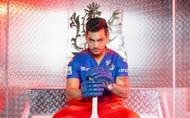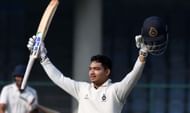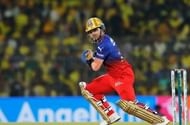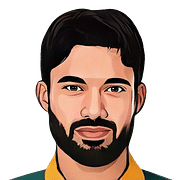Personal Information
| Full Name | Anuj Rawat |
| Date of Birth | October 17, 1999 |
| Age | 25 Years |
| Nationality | Indian |
| Birth Place | Ram Nagar, Uttarakhand |
| Height | 5 ft 7 in |
| Current Team(s) | |
| Role | Wicketkeeper-batter |
| Batting Style | Left-hand Bat |
| Past Team(s) | |
| Jersey No. | 55 |
| Family | Virendra Pal Singh Rawat (Father), Satish Pokhriyal (Coach) |
Most Recent Matches
| Match | R | BF | 4s | 6s | S/R | O | R | W | E/R |
|---|---|---|---|---|---|---|---|---|---|
| EDR vs WDL | 15 | 18 | 1 | 0 | 83.33 | 0.3 | 5 | 0 | 10.00 |
| EDR vs CDK | 23 | 26 | 2 | 1 | 88.46 | 0 | 0 | 0 | 0 |
| CDK vs EDR | 0 | 1 | 0 | 0 | 0.00 | 0 | 0 | 0 | 0 |
| EDR vs PD | 59 | 36 | 6 | 2 | 163.89 | 0 | 0 | 0 | 0 |
| PD vs EDR | 3 | 5 | 0 | 0 | 60.00 | 0 | 0 | 0 | 0 |
Batting Stats
View All| Game Type | Mat | Inn | R | BF | NO | Avg | S/R | 100s | 50s | H | 4s | 6s | Ct | St |
|---|---|---|---|---|---|---|---|---|---|---|---|---|---|---|
| T20s | 71 | 63 | 1259 | 1043 | 14 | 25.69 | 120.70 | 0 | 5 | 88 | 107 | 55 | 62 | 11 |
| LISTAs | 32 | 27 | 888 | 1025 | 6 | 42.28 | 86.63 | 0 | 8 | 95 | 71 | 33 | 43 | 7 |
| FIRSTCLASS | 34 | 53 | 1435 | 2509 | 3 | 28.70 | 57.19 | 3 | 5 | 134 | 155 | 30 | 87 | 14 |
Bowling Stats
View All| Game Type | Mat | Inn | O | R | W | Avg | E/R | Best | 5w | 10w |
|---|---|---|---|---|---|---|---|---|---|---|
| T20s | 71 | 1 | 1.0 | 14 | 0 | 0 | 14.00 | 0 | 0 | 0 |
| LISTAs | 32 | 0 | 0 | 0 | 0 | 0 | 0 | 0 | 0 | 0 |
| FIRSTCLASS | 34 | 0 | 0 | 0 | 0 | 0 | 0 | 0 | 0 | 0 |
Popular Players
Anuj Rawat: A Brief Biography

Born on October 17, 1999, in Ram Nagar, Uttarakhand, Anuj Rawat is a left-handed batter who dons the gloves for Delhi in the domestic circuit and the Royal Challengers Bengaluru in the Indian Premier League.
Rawat is a young, talented southpaw with a healthy average in the late 30s in the initial days of his First-Class cricketing career. He has already breached the IPL gates and it's only a matter of time before he showcases his talent on the world stage.
Anuj Rawat: Along the Years
| Year | Age | Achievement |
| 2017 | 17 | Made Ranji Trophy Trophy debut for Delhi |
| 2018 | 18 | Played in the ACC Under 19s Asia Cup 2018 |
| 2018 | 18 | Won the ACC Under 19s Asia Cup 2018 |
| 2019 | 19 | Made Syed Mushtaq Ali Trophy debut against Jharkhand |
| 2019 | 19 | Made Vijay Hazare Trophy debut against Baroda |
| 2019 | 20 | Bought by Rajasthan Royals for INR 80 lakhs |
| 2021 | 21 | Made IPL debut against Sunrisers Hyderabad |
| 2022 | 22 | Bought by Royal Challengers Bangalore (now Royal Challengers Bengaluru) for INR 3.4 crores |
Anuj Rawat Career
Anuj Rawat shot to the limelight after playing a few cameos down the order for the Royal Challengers Bengaluru. His left-handed batter capacity and wicket-keeping abilities would make him a serious middle-order lookout.
Anuj Rawat Domestic Career
Anuj Rawat made his first-class debut for Delhi in the 2017–18 Ranji Trophy on October 06, 2017, and scored 71 and 13 runs in the two innings of the match. He also managed to effect two dismissals behind the stumps. He scored a career-best 134 against Madhya Pradesh in the 2018-19 Ranji Trophy season and was adjudged the ‘Player of the Match.’

The 24-year-old played for Delhi during the 2019-20 edition of the Syed Mushtaq Ali Trophy and scored an impressive 88* against Saurashtra.
As of July 2024, Anuj Rawat has featured in 31 first-class games and scored 1338 runs, averaging 29.08. He has also featured in 90 short-format games across List A and T20 cricket, averaging a decent 33.15 and 24.06 respectively. With the gloves, the 24-year-old has affected 204 dismissals across domestic cricket.
If we go by the statistics, it wouldn't be a hyperbole to predict that Anuj Rawat has the ingredients to become one of the best wicket-keeper batsmen for India in the future.
Anuj Rawat IPL Career
The Rajasthan Royals, impressed by his performance in the Syed Mushtaq Ali Trophy, decided to rope Anuj Rawat for INR 80 Lakhs at the IPL auction in December 2019. He did not feature in a single game that season, but the Royals decided to retain him for IPL 2021 and he made his debut against Sunrisers Hyderabad. He did not get to bat in the two matches he played and was released ahead of the IPL 2022 mega auction.

In the IPL 2022 mega auction, the Royal Challengers Bangalore (now Royal Challengers Bengaluru) signed the uncapped player for a hefty INR 3.4 crores. He scored his maiden IPL half-century against the Mumbai Indians and was adjudged the ‘Player of The Match.’

In the next two seasons, he got scratchy game time due to the availability of veteran wicketkeeper-batter Dinesh Karthik. In the opening match of IPL 2024, he top-scored for the Royal Challengers against the Chennai Super Kings with 48 runs off just 25 balls at a strike rate of 192 and stitched a partnership of 95 runs for the sixth wicket with Dinesh Karthik when half the side was back to the pavilion for 78 runs. With Dinesh Karthik retiring from IPL, young Rawat has huge shoes to fill for the Royal Challengers in the coming seasons.

Anuj Rawat Under-19 Career
Anuj Rawat was appointed as the captain of the Under-19 team when the Indian U-19 toured Sri Lanka. The team consisted of the likes of legendary batter Sachin Tendulkar’s son Arjun Tendulkar. He then featured in the Indian U-19 squad that went on to win the ACC Under 19s Asia Cup 2018 which faced Sri Lanka U-19 in the final.
Anuj Rawat’s Family
Anuj Rawat comes from a middle-class background that struggled to fund the youngster’s cricketing career during his initial days. His father Virendra Pal Singh Rawat struggled to aid him financially with the mediocre returns he gained from farming and took loans to fund his career. Hailing from a small village Roorpur in Ramnagar in the Nainital district, he was advised to be coached in New Delhi for better cricketing facilities and was eventually guided under Virat Kohli’s childhood coach Rajkumar Sharma.
Anuj Rawat’s Net Worth
As of 2024, Anuj Rawat’s net worth is estimated to be around INR 8 crores or USD 1 million.
Anuj Rawat’s House
Though Anuj Rawat’s family hails from the village of Roorpur in Ramnagar, he currently resides in an apartment in Janakpuri in Delhi.
FAQs on Anuj Rawat
A. Though Anuj Rawat was bought by the Rajasthan Royals in the IPL 2020 auction, he made his IPL debut against Sunrisers Hyderabad in IPL 2021.
A. Anuj Rawat was sold to the Chennai Super Kings for INR 3.4 crores in the IPL 2022 mega auction.
A. Anuj Rawat represented India in the ACC Under-19s Asia Cup in 2018.
A. Anuj Rawat scored his career-best score of 134 in a Ranji Trophy match against Madhya Pradesh in December 2018.
A. Anuj Rawat played for the Royal Challengers Bengaluru in IPL 2024.


































































































![“Main sundar nahin dikhta?” - Ishant Sharma’s hilarious banter with teammate ahead of RCB vs GT IPL 2025 match [Watch]](https://staticg.sportskeeda.com/editor/2025/04/2d3c9-17435832654166-1920.jpg?w=668)
![Gujarat Titans keeper sings ‘Aaj ki party’ song loudly in Rashid Khan’s ears while he is sleeping ahead of RCB vs GT IPL 2025 match [Watch]](https://staticg.sportskeeda.com/editor/2025/04/6a373-17435824672855-1920.jpg?h=166)

![[Watch] KKR’s ₹23.75 crore purchase picks up 2 wickets in 1 over in SMAT 2024 semifinal between Delhi and MP](https://staticg.sportskeeda.com/editor/2024/12/bd8cd-17340964256930-1920.jpg?h=166)
